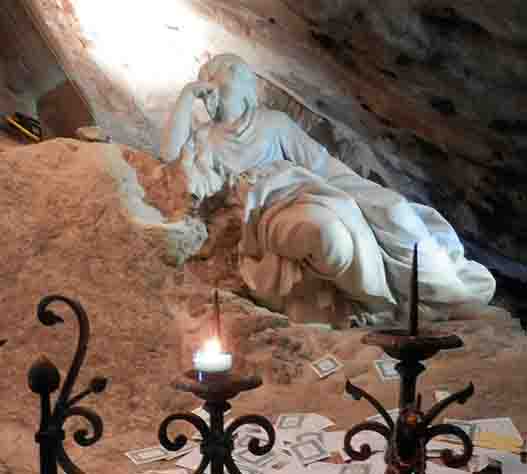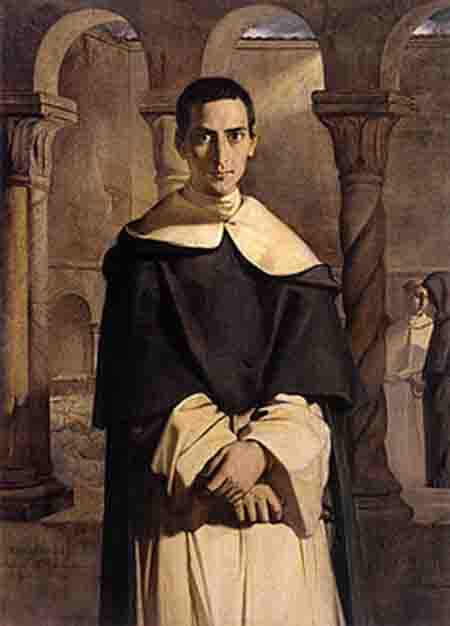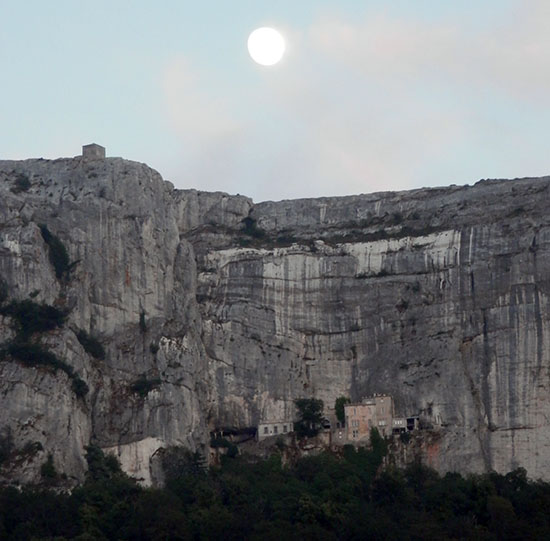by Paula Lawlor—based on writings of Henri-Dominique Lacordaire, OP
The Massif-de-la-Sainte-Baume is a mountain ridge spreading between the departments of Bouches-du-Rhône and Var in southern France. Its summit is 3700 feet high. Its treasure is La Sainte-Baume, which means “holy cave” in provincial dialect.
La Sainte-Baume is the Cave of Saint Mary Magdalene. This grotto and the house of the Dominican Father guardian are chiseled into the rock-face. On the crest is Chapel St. Pilon, built in memory of Saint Mary Magdalene being raised up by angels seven times daily. Over the centuries pilgrims have come to this holy cave to venerate a great mystery of God’s love.
Surely God thought of Mary Magdalene when He created this particular spot in the world. He deliberately prepared for her a special corner of the Earth, a sanctuary.
The French tradition is that Mary Magdalene, her brother Lazarus, sister Martha, Maximin (one of the seventy-two disciples) and some companions, were expelled by persecutions from the Holy Land. They sailed the Mediterranean in a frail boat with neither rudder nor mast and landed at the place called Saintes-Maries-de-la-Mer near Arles. Mary Magdalene came to Marseille with her companions on the boat and they together converted the whole of Provence.
Her brother Lazarus stayed in Marseille, her sister Martha went on to Tarascon. Mary Magdalene and Maximin traveled on foot to Aix. There was an oratory where she and Maximin prayed which was called Saint-Sauveur. Today you can still see the original floor of that oratory inside the Cathédrale Saint Sauveur in Aix-en-Provence. The tradition was so firmly believed that it looked upon Saint-Sauveur as the cradle of Christianity in the capital of Provence. But Aix, no more than Marseille, was the predestined spot where Jesus Christ was to await his old and faithful friend to enable her to enjoy that role which she preferred, which was the role of contemplation in solitude.
A grace drew Mary Magdalene to La Sainte-Baume, the same grace that had chosen her, a sinner, led her to the foot of the Cross, and rendered her, at the gates of death, the first witness of the resurrection of the Son of God. She came there as she had gone to Christ, by the same light and the same movement. She carried up to the sacred heights of La Sainte-Baume the virtue of friendship that has no equal, and it leaves a profound memory that never dies.
There, separated from the men who crucified her Savior and the Savior of the world, she had only one thought, that of seeing again the divine friend whom she had lost. For neither distance nor death breaks true love; rather it digs deeper into the soul the more it is deprived of an outlet. And if you have ever witnessed one who had lost a son or a wife, you can imagine the loss Mary Magdalene would have felt having held the feet of the Son of God, and who had loved him beyond all natural friendship.
Therefore it is believable when tradition tells us that each day, and seven times a day, she was taken up from her grotto to the top of the rock that covered it, to hear the angels sing.
La Sainte-Baume was the Mount Tabor (where Christ was transfigured) for Mary Magdalene. She lived there in solitude, between the penances of the grotto and the ecstasies on high. This was a kind of transfiguration for Mary Magdalene, from the needs of her physical body to a spiritual fulfillment. She was sustained by faith and divine love. Nothing has changed there, any more than at Tabor. From the peaks of these two mountains you can look on high, to the God who visited them.
For thirty years God gave this spectacle to his angels so as to leave a memory for the rest of time. For thirty years Mary Magdalene went from a state of penance to one of glory and from one of glory to one of penance, and reunited in those altering states the double life that she had led, that of the sinner and that of the friend of Jesus. And it was to the Rock of Penitence inside her cave that she used to pray.
 The Rock of Penitence behind the altar in La Sainte-Baume
The Rock of Penitence behind the altar in La Sainte-Baume
Outside, on the sheer side of the mountain and at its highest point, but slightly to the left of the grotto, is the point marked by tradition as that where Mary Magdalene was lifted each day. Chapel St. Pilon consecrates the site and attracts to it the veneration of the pilgrims. From this spot is a view of the Mediterranean Sea.
During the French Revolution (1793) a fire was deliberately started in the cave causing great destruction. From 1814 onward La Sainte-Baume was little by little rebuilt from its ashes until, in 1859, Fr. Henri-Dominique Lacordaire, OP re-installed the Dominican Order which had been faithful keepers of her relics and guides to pilgrims.
Almost 2000 years ago a small boat brought Mary Magdalene to the soil of France, and since then a prodigious succession of things had, one after the other, confirmed and increased the splendor of her memory. La Sainte-Baume, where Jesus had resumed with her the conversations interrupted at the Holy Sepulchre had become one of the mountains celebrated by the visit of God. And a few miles away, in St. Maximin, her burial was never forgotten. The alabaster tomb where her body was discovered outlasted the alabaster jar in which she poured the perfume over the feet of the Savior. In the crypt behind a grill her skull is there for all to see, only taken out during the feast day week (July 22nd) to be present in the Church during the special Masses and carried in procession through the streets of St. Maximin after her feast day Mass.
Henri-Dominique Lacordaire, OP (1802 – 1861)
 Fr. Henri-Dominique Lacordaire, OP at the Convent of Santa Sabina in Rome
Fr. Henri-Dominique Lacordaire, OP at the Convent of Santa Sabina in Rome
In 1837, Lacordaire decided to enter the Dominican Order and to re-establish the Dominicans in France. Pope Gregory XVI and the general master of the Dominicans, Fr. Ancarani, supported his plan, the latter providing the Roman convent of Santa Sabina to serve as a novitiate for French Dominicans.
Fr. Lacordaire was interested in La Sainte-Baume and decided to renew this place of pilgrimage. In 1859, he rebuilt the Hôtellerie-de-la-Sainte-Baume on the plain below La Sainte-Baume at the edge of the forest. It is the priory of the Dominican brethren, and they also continue to receive pilgrims there throughout the year.
Fr. Lacordaire wanted to give witness to the Gospel. He wrote in his study on Saint Mary Magdalene: “When the Son of God came to save men, nobody was astonished that the Gospel might be a book of love and Love the book of salvation.”
La Sainte-Baume has always been a source of grace.
Written for the Society of Saint Mary Magdalene’s newsletter



I look forward to spending time in all these holy places.